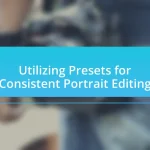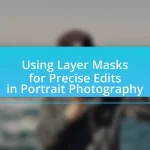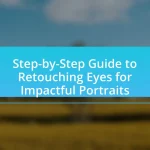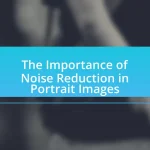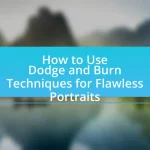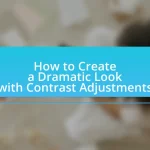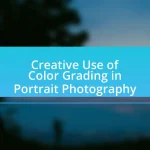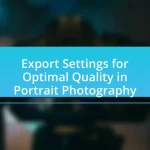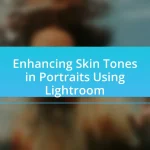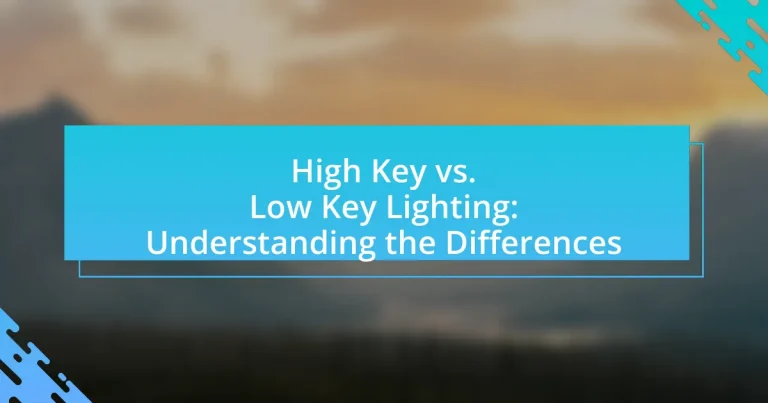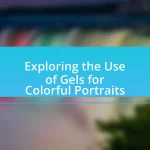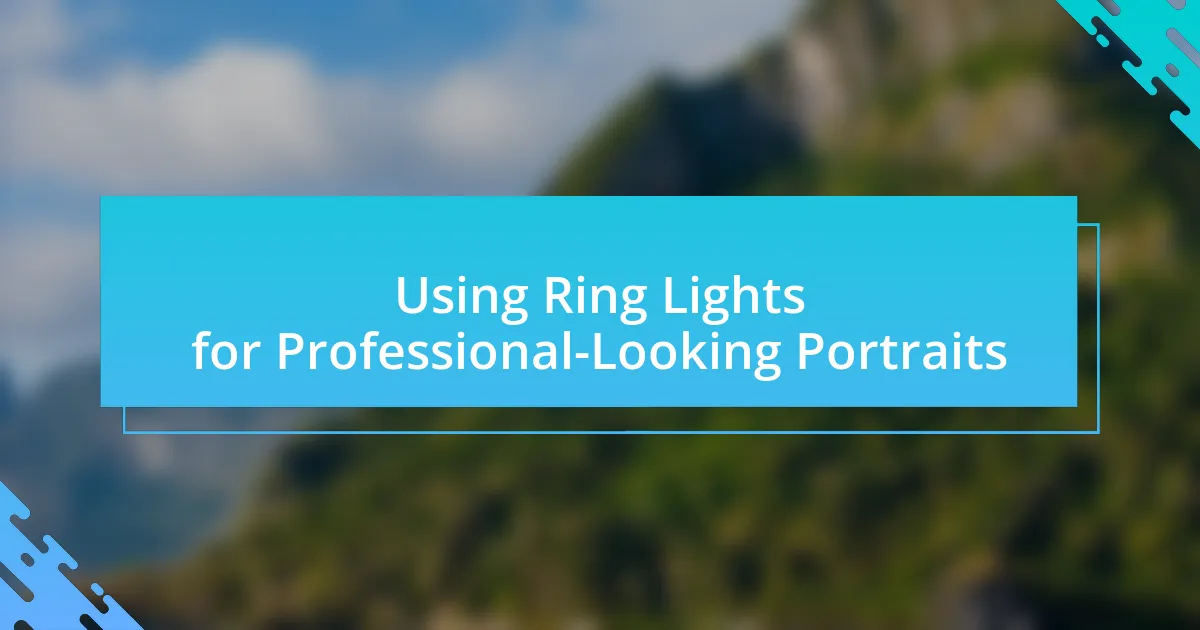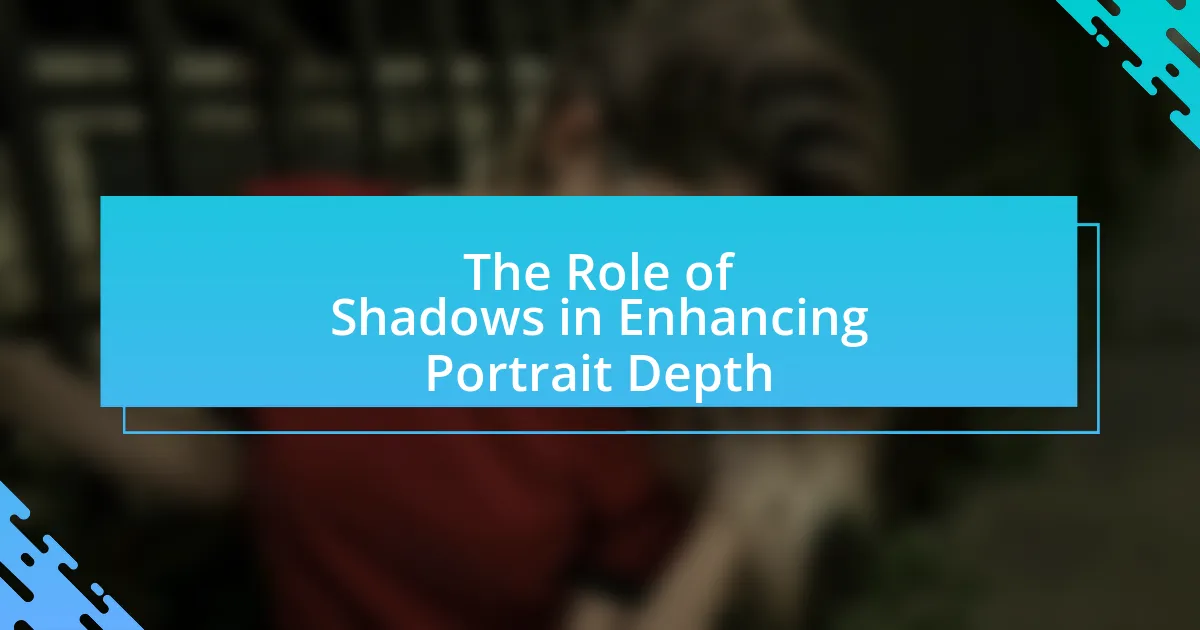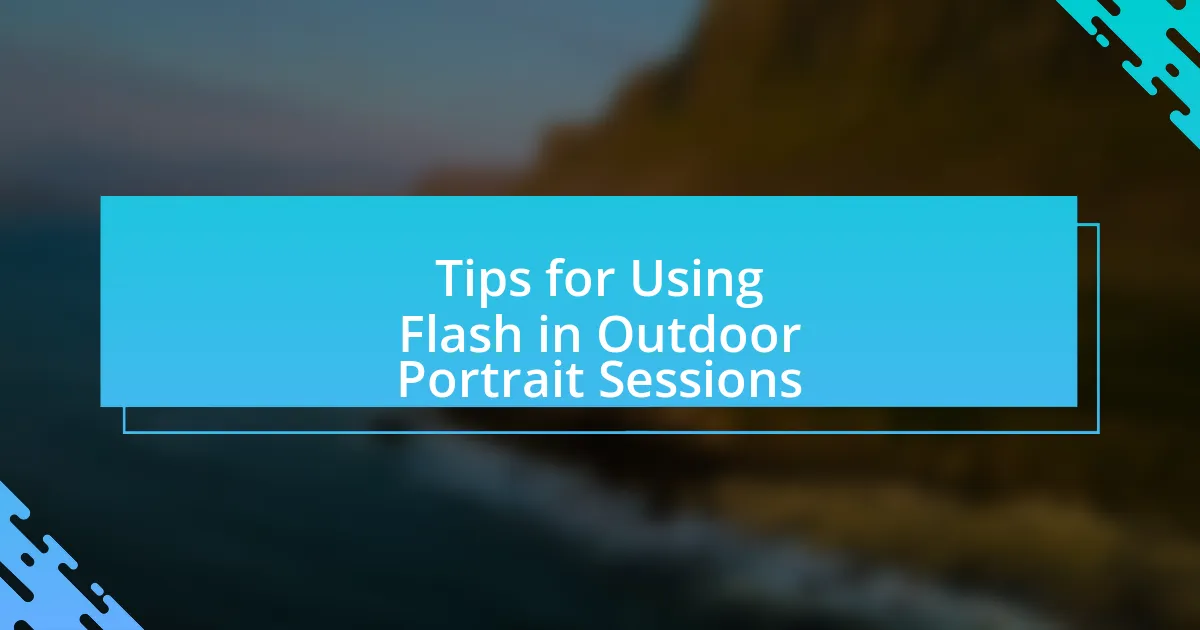High Key and Low Key Lighting are two fundamental techniques in photography and cinematography that create distinct visual atmospheres. High Key Lighting is characterized by bright, even illumination with minimal shadows, often used in cheerful genres like comedies and commercials, while Low Key Lighting features strong contrasts and deep shadows, creating a moody ambiance suitable for thrillers and horror films. This article explores the differences in exposure, characteristics, and practical applications of both lighting styles, highlighting their importance in shaping emotional responses and visual narratives in visual storytelling. Additionally, it provides insights into effective techniques, equipment needed, and common pitfalls to avoid when utilizing these lighting methods.
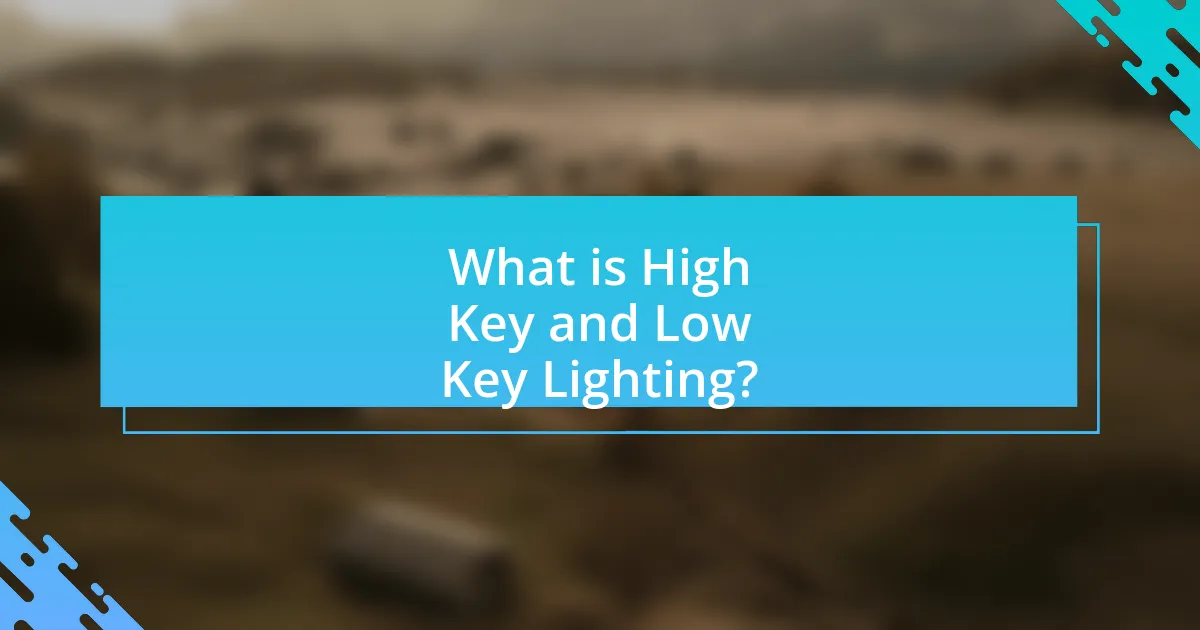
What is High Key and Low Key Lighting?
High key lighting is a technique characterized by bright, even illumination with minimal shadows, often used to create a cheerful or upbeat atmosphere. In contrast, low key lighting involves strong contrasts between light and dark, producing dramatic shadows and a moody ambiance. High key lighting is commonly utilized in genres like comedies and commercials, while low key lighting is prevalent in thrillers and horror films, emphasizing tension and emotion.
How do High Key and Low Key Lighting differ in terms of exposure?
High Key lighting features a higher overall exposure, resulting in bright, evenly lit scenes with minimal shadows, while Low Key lighting has a lower exposure, creating darker scenes with pronounced shadows and contrast. High Key lighting typically uses multiple light sources to reduce contrast, achieving a soft and airy feel, whereas Low Key lighting employs fewer light sources, emphasizing dramatic effects and depth through shadow. This distinction in exposure directly influences the mood and visual storytelling in photography and cinematography.
What are the characteristics of High Key Lighting?
High Key Lighting is characterized by a bright and evenly distributed illumination that minimizes shadows and contrast. This lighting style often employs multiple light sources to achieve a soft, cheerful atmosphere, making it ideal for genres like comedy and fashion photography. The absence of harsh shadows and the predominance of light tones create a sense of openness and positivity, which is frequently utilized in commercial and promotional media to convey a sense of clarity and approachability.
What are the characteristics of Low Key Lighting?
Low key lighting is characterized by a high contrast between light and shadow, creating a dramatic and moody atmosphere. This lighting technique often employs a single light source, which casts deep shadows and emphasizes textures and shapes within the scene. The use of low key lighting is prevalent in genres such as film noir and horror, where it enhances tension and evokes emotion. Additionally, low key lighting typically results in a limited color palette, often favoring darker tones, which further contributes to its somber and intense visual impact.
Why are High Key and Low Key Lighting important in photography and film?
High Key and Low Key Lighting are important in photography and film because they create distinct emotional atmospheres and visual narratives. High Key Lighting, characterized by bright, even illumination and minimal shadows, conveys a sense of positivity, clarity, and openness, often used in genres like comedy and fashion. Conversely, Low Key Lighting, which features strong contrasts and deep shadows, evokes feelings of mystery, tension, or drama, commonly utilized in horror and thriller genres. The effectiveness of these lighting styles is supported by their ability to influence viewer perception and emotional response, as evidenced by studies in visual storytelling that highlight how lighting shapes audience engagement and mood.
How does High Key Lighting influence mood and tone?
High key lighting creates a bright and evenly lit environment, which generally evokes feelings of happiness, openness, and positivity. This lighting technique minimizes shadows and contrasts, resulting in a cheerful and uplifting atmosphere. Studies in cinematography and photography indicate that high key lighting is often used in genres such as comedies and light-hearted films to reinforce a sense of joy and lightness, as seen in classic Hollywood musicals. The absence of harsh shadows contributes to a more inviting and friendly tone, making it effective in settings where a warm, approachable mood is desired.
How does Low Key Lighting create dramatic effects?
Low Key Lighting creates dramatic effects by utilizing strong contrasts between light and shadow, which emphasizes mood and tension in visual storytelling. This technique often involves a single light source that casts deep shadows, resulting in a stark, moody atmosphere that can evoke feelings of suspense or intrigue. For example, in film noir, low key lighting is frequently employed to highlight characters’ emotions and create a sense of mystery, as seen in classic films like “The Maltese Falcon.” The interplay of light and shadow not only shapes the visual composition but also guides the audience’s emotional response, making it a powerful tool in cinematography and photography.
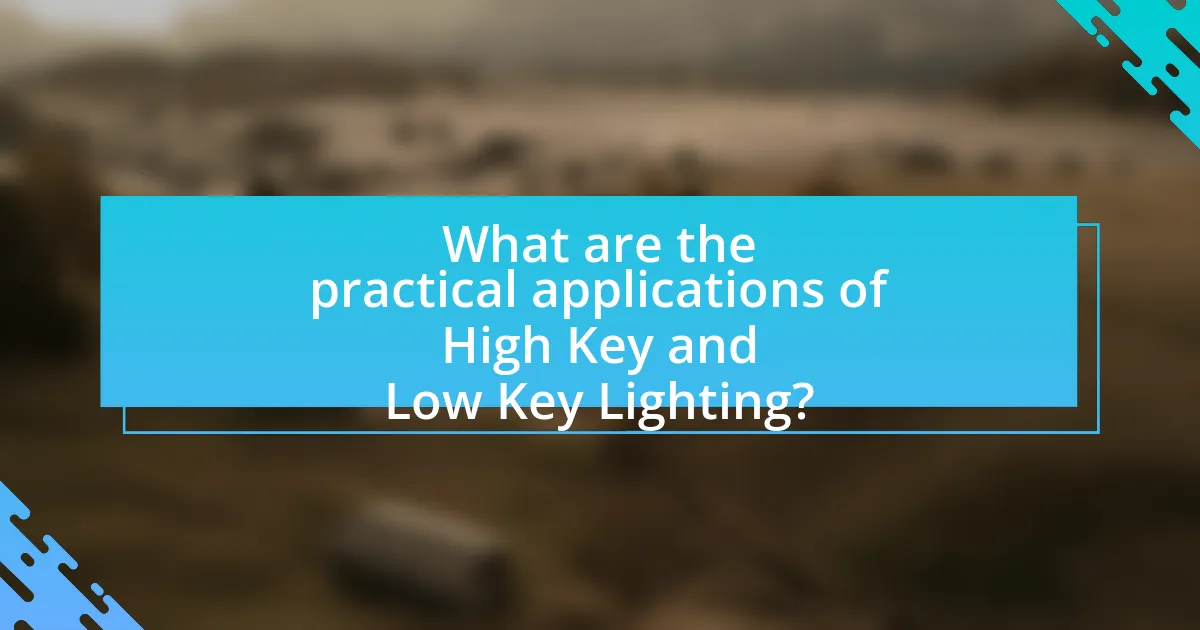
What are the practical applications of High Key and Low Key Lighting?
High Key and Low Key Lighting have distinct practical applications in photography, film, and visual arts. High Key Lighting is often used in fashion photography, commercials, and cheerful scenes to create a bright, airy atmosphere that minimizes shadows and conveys a sense of positivity. This technique enhances the subject’s features and is effective in promoting products or creating an inviting mood. Conversely, Low Key Lighting is utilized in dramatic scenes, horror films, and portrait photography to create a moody, mysterious atmosphere by emphasizing shadows and contrast. This approach highlights the subject’s contours and evokes emotional responses, making it suitable for storytelling that requires tension or intrigue.
In what scenarios is High Key Lighting typically used?
High Key Lighting is typically used in scenarios that require a bright, cheerful, and upbeat atmosphere, such as in fashion photography, commercials, and sitcoms. This lighting technique minimizes shadows and creates an even illumination, which enhances the subject’s features and conveys a sense of positivity. For example, in fashion photography, High Key Lighting helps to highlight clothing details and textures, making the images more appealing to viewers. Additionally, sitcoms often utilize this lighting style to create a lighthearted mood that aligns with comedic content.
What types of subjects benefit from High Key Lighting?
High Key Lighting benefits subjects that require a bright, cheerful, and uplifting appearance, such as fashion models, product photography, and children. This lighting technique minimizes shadows and creates a soft, even illumination, which enhances the visual appeal of these subjects. For instance, in fashion photography, High Key Lighting is often used to convey a sense of freshness and vitality, making the clothing and accessories stand out. Similarly, in product photography, this lighting helps to highlight the details and colors of the items, making them more attractive to consumers.
How can High Key Lighting enhance commercial photography?
High Key Lighting enhances commercial photography by creating a bright, evenly lit scene that minimizes shadows and highlights the subject. This lighting technique is particularly effective for product photography, as it emphasizes colors and details, making items appear more appealing to consumers. Studies show that images with high key lighting can increase viewer engagement and improve brand perception, as they convey a sense of cleanliness and positivity. For instance, a survey by the American Marketing Association found that products photographed in high key lighting were perceived as more desirable, leading to a 20% increase in purchase intent among consumers.
In what scenarios is Low Key Lighting typically used?
Low Key Lighting is typically used in scenarios that require a dramatic or moody atmosphere, such as in film noir, horror films, and certain types of photography. This lighting technique emphasizes shadows and contrasts, creating a sense of mystery or tension. For example, in film noir, low key lighting is employed to highlight the moral ambiguity of characters, while in horror films, it enhances suspense by obscuring details. The use of low key lighting is effective in storytelling, as it visually communicates emotions and themes through its stark contrasts and shadow play.
What types of subjects benefit from Low Key Lighting?
Low key lighting benefits subjects that require dramatic emphasis, such as portraits, still life, and moody scenes. This lighting technique creates strong contrasts between light and shadow, enhancing textures and shapes, which is particularly effective for capturing emotions in portrait photography. Additionally, low key lighting is often used in film and theater to evoke suspense or tension, making it suitable for characters in thrillers or horror genres. The effectiveness of low key lighting in these contexts is supported by its ability to draw attention to specific features while obscuring others, thus creating a more engaging visual narrative.
How can Low Key Lighting enhance storytelling in film?
Low key lighting enhances storytelling in film by creating a dramatic atmosphere that emphasizes tension and mood. This lighting technique utilizes strong contrasts between light and shadow, which can evoke emotions and highlight character complexities. For instance, films like “The Godfather” effectively use low key lighting to underscore themes of power and moral ambiguity, drawing viewers into the psychological depth of the characters. The strategic use of shadows can also obscure details, fostering intrigue and suspense, which are essential elements in genres such as noir and horror.

How can one effectively use High Key and Low Key Lighting techniques?
To effectively use High Key and Low Key Lighting techniques, one should understand their distinct characteristics and applications. High Key Lighting involves bright, even illumination with minimal shadows, often used in fashion and commercial photography to create a cheerful and vibrant atmosphere. This technique can be achieved by using multiple light sources and reflectors to fill in shadows, ensuring a soft and flattering look.
Conversely, Low Key Lighting emphasizes dramatic contrasts with deep shadows and selective highlights, commonly utilized in portrait and cinematic photography to evoke mood and tension. This can be accomplished by using a single light source positioned at an angle to create stark contrasts, while the background remains dark to enhance the subject’s features.
Both techniques require careful control of light placement and intensity to achieve the desired effect, making them powerful tools in visual storytelling.
What equipment is needed for High Key Lighting setups?
High Key Lighting setups require softbox lights, reflectors, and a backdrop. Softbox lights diffuse light to reduce harsh shadows, while reflectors help bounce light to fill in any remaining shadows, creating an even illumination. A seamless backdrop, often white or light-colored, enhances the high key effect by minimizing distractions and maintaining a bright aesthetic. These components work together to achieve the characteristic bright and airy look associated with high key lighting.
How do lighting modifiers affect High Key Lighting?
Lighting modifiers significantly influence High Key Lighting by controlling the quality, direction, and intensity of light. These modifiers, such as softboxes, umbrellas, and reflectors, diffuse and soften the light, creating a more even and flattering illumination that is characteristic of High Key setups. For instance, softboxes reduce harsh shadows and create a gentle light spread, which is essential for achieving the bright, airy feel associated with High Key Lighting. Additionally, reflectors can bounce light back onto the subject, enhancing brightness and reducing contrast, further contributing to the desired high-key effect. This manipulation of light through modifiers is crucial in photography and videography, where achieving a specific aesthetic is often dependent on the precise control of lighting conditions.
What are some tips for achieving the perfect High Key look?
To achieve the perfect High Key look, use bright, even lighting to minimize shadows and create a light, airy atmosphere. This can be accomplished by utilizing multiple light sources, such as softboxes or diffused natural light, to illuminate the subject uniformly. Additionally, choose a light-colored background to enhance the brightness and maintain a clean aesthetic. High Key photography often features high exposure settings, so adjusting the camera settings to increase brightness while avoiding overexposure is crucial. This technique is supported by the fact that High Key lighting is commonly used in fashion and portrait photography to convey a sense of positivity and openness.
What equipment is needed for Low Key Lighting setups?
Low key lighting setups require specific equipment to achieve their characteristic dramatic effect. Essential items include a key light, typically a strong light source such as a spotlight or softbox, to create deep shadows and contrast. Additionally, a fill light is often used, albeit at a lower intensity, to soften shadows without eliminating them entirely. A background light can also be beneficial to separate the subject from the background, enhancing depth. Finally, light modifiers like flags or reflectors help control light spill and shape the lighting further. These components work together to create the desired low key aesthetic, characterized by high contrast and moody atmospheres.
How do shadows play a role in Low Key Lighting?
Shadows are essential in low key lighting as they create depth and enhance the dramatic effect of the scene. In low key lighting, the use of strong contrasts between light and dark areas emphasizes shadows, which can evoke emotions and highlight specific features of the subject. This technique is often employed in film and photography to convey mood, tension, or mystery, as seen in genres like film noir. The presence of shadows in low key lighting not only shapes the visual narrative but also guides the viewer’s focus, making them a critical element in achieving the desired aesthetic.
What are some tips for mastering Low Key techniques?
To master Low Key techniques, focus on controlling light and shadow to create dramatic effects. Utilize a single light source to emphasize contrast, ensuring that the subject is well-lit while the background remains dark. Experiment with different angles and distances of the light source to manipulate shadows effectively. Additionally, use reflectors to bounce light back onto the subject, enhancing details without overpowering the low-key effect. Understanding the inverse square law of light can also help in achieving the desired intensity and fall-off, allowing for precise control over the lighting setup.
What are some common mistakes to avoid when using High Key and Low Key Lighting?
Common mistakes to avoid when using High Key and Low Key Lighting include overexposure in High Key setups and insufficient contrast in Low Key setups. In High Key lighting, failing to control exposure can lead to loss of detail in bright areas, resulting in a flat image. Conversely, in Low Key lighting, not utilizing enough contrast can make the subject appear lost in shadows, diminishing visual interest. Properly balancing light intensity and shadow depth is crucial for achieving the desired effect in both lighting styles.
How can overexposure affect High Key Lighting results?
Overexposure can significantly diminish the effectiveness of High Key Lighting by washing out details and creating a flat appearance. High Key Lighting aims to produce bright, even illumination with minimal shadows, but when overexposure occurs, it leads to loss of contrast and texture, making the image appear lifeless. This is particularly problematic in photography and film, where the intended vibrant and cheerful aesthetic can be compromised. Studies in photography techniques indicate that maintaining proper exposure levels is crucial for achieving the desired visual impact, as overexposed images often result in clipped highlights and a lack of depth, which are essential characteristics of successful High Key compositions.
What pitfalls should be avoided in Low Key Lighting setups?
In Low Key Lighting setups, one should avoid overly harsh shadows, which can create an unflattering or distracting effect. Properly managing the light sources is crucial; using too few lights can lead to excessive darkness, while too many can eliminate the desired contrast. Additionally, neglecting to control the background can result in unwanted distractions that detract from the subject. Maintaining a balance between light and shadow is essential for achieving the intended dramatic effect, as evidenced by the fact that successful Low Key Lighting often relies on a careful interplay of these elements to evoke mood and depth.
What are the best practices for combining High Key and Low Key Lighting?
The best practices for combining High Key and Low Key Lighting involve balancing the intensity and placement of light sources to achieve a harmonious effect. Start by using High Key lighting to create a bright, even base, which can be achieved with soft, diffused light sources that minimize shadows. Then, introduce Low Key lighting strategically to add depth and contrast; this can be done by using directional, harder light sources to highlight specific areas or subjects.
To maintain a cohesive look, ensure that the transition between the two lighting styles is smooth, avoiding harsh contrasts that can distract from the subject. Additionally, consider the color temperature of the lights; using similar color temperatures helps unify the overall aesthetic.
These practices are supported by the principles of lighting design, which emphasize the importance of contrast and balance in visual storytelling.
How can one transition between High Key and Low Key Lighting in a single project?
To transition between High Key and Low Key Lighting in a single project, one can adjust the lighting setup by gradually decreasing the intensity of the lights while increasing the use of shadows. This method allows for a smooth shift from the bright, even illumination characteristic of High Key Lighting to the dramatic contrasts and darker tones of Low Key Lighting. For instance, starting with multiple soft light sources to create a bright atmosphere, one can then reduce the number of lights or dim them, while introducing hard light sources to cast shadows, effectively creating a layered lighting effect that transitions seamlessly. This approach is supported by lighting techniques used in film and photography, where the manipulation of light and shadow is essential for mood and tone.
What creative effects can be achieved by blending both lighting styles?
Blending high key and low key lighting styles can create dynamic visual contrasts and enhance emotional depth in photography and film. This combination allows for a balanced interplay between bright, evenly lit areas and dramatic shadows, resulting in a more nuanced image. For instance, using high key lighting to illuminate the subject while incorporating low key elements in the background can draw attention to the subject and evoke a sense of intrigue or tension. Additionally, this technique can highlight textures and details, making the composition more engaging. The effectiveness of this blending is supported by the principles of visual storytelling, where contrasting lighting can influence audience perception and emotional response.

